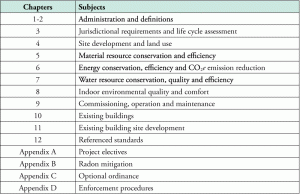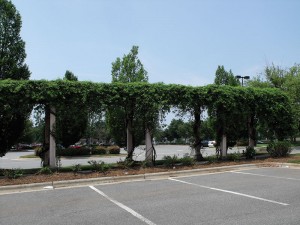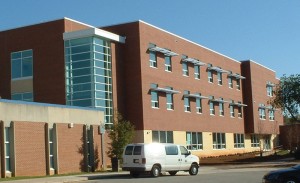Why a Code?
In March 2012, the International Code Council (ICC) published the first edition of the International Green Construction CodeTM (2012 IGCCTM). The need for the development of a code-enforcable set of green building requirements arose from the fact that, throughout the U.S., LEED® certification of buildings was increasingly mandated by government. But as a voluntary, choice-driven rating system, LEED is ill-suited to enforcement by local building codes. Thus, the IGCC was developed as a mandatory language, overlay model code that contains a minimum set of requirements for green buildings that is easily adoptable by jurisdications. The IGCC is intended to be adopted in conjuction with the other I-codes, including the 2012 International Building Code (IBC) and the 2012 International Energy Conservation Code (IECC). Numerous jurisdictions throughout the U.S. have already adopted the 2012 IGCC, in whole or in part.
The content of the 2012 IGCC is roughly equivalent to a codified version of the 2009 Leadership in Energy and Environmental Design (LEED®) for New Construction rating system at a basic level. Jurisdictional requirements and project electives allow for the addition of optional requirements to be implemented. The following describes these options as well as provisions most likely of interest to the structural engineer.
Scope and Organization
The 2012 IGCC is organized into 12 chapters and 4 appendices (see Table). The IGCC applies to all occupancies, except temporary structures. Most low-rise residential structures are excluded, unless the jurisdiction specifically chooses to include them and then the requirements of the National Green Building Standard (ICC 700) apply. Section 101 of the IGCC also recognizes ASHRAE Standard 189.1-2011, Standard for the Design of High-Performance Green Buildings Except Low-Rise Residential Buildings, as an alternate compliance path.
Jurisdictional Requirements
Chapter 3 of the IGCC contains requirements that are “specific to and selected by” the jurisdiction. Table 302.1 is used to indicate requirements selected, which are in addition to the minimum provisions of the IGCC. Once chosen, these provisions are to be enforced as mandatory requirements. Requirements in Table 302.1, of interest to structural and civil engineers, include:
- inclusion of residential buildings with corresponding compliance with ICC 700;
- whether construction in flood hazard areas is excluded;
- whether construction near surface water (such as lakes, rivers, etc) is excluded;
- whether construction on greenfield sites is excluded. Greenfields are identified in the IGCC as areas without existing infrastructure and/or not near public transit and the like.
- the minimum percentage of construction waste that must be diverted from landfill;
- whether acoustic requirements apply; and
- whether enhanced energy efficiency is desired.
Chapter 3 also contains the option for whole building life cycle assessment (LCA). If a whole building LCA is performed in accordance with the provisions of Section 303.1, the material requirements of Section 505 do not apply. Section 303.1 (LCA) requires a 20% improvement “… in environmental performance for global warming potential and at least two … impact measures, as compared to a reference design….” The impact measures to be evaluated are primary energy use, acidification potential, eutrophication potential, ozone depletion potential, and smog potential. As the building structure constitutes a significant portion of the environmental impact for many buildings, the structural engineer must work closely with the design team and the LCA consultant if this approach is pursued.
Project Electives
Project electives are found in Appendix A of the IGCC. These provisions are not mandatory unless specifically referenced in the adopting ordinance. This appendix provides “…a basis by which a jurisdiction can implement measures to increase natural resource conservation, material resource conservation, energy conservation, water conservation and environmental comfort and mitigate impacts of building site development.” The jurisdiction must specify the minimum number of project electives required in each of the areas of the site (Table A104), materials (Table A105), energy (Table A106), water (Table A107), and indoor environment (Table A108). Zero electives can be specified.
Though similar to jurisdictional requirements in that they allow the jurisdiction to tailor the IGCC to their locale, project electives allow the owner/design team flexibility to choose specific project electives for the project. Selected project electives are then treated as mandatory (code) requirements. Project electives of interest to the engineer are discussed herein.
Site Development and Land Use
Chapter 4 contains requirements related to site development and land use. Specifically, this chapter contains mandatory requirements for stormwater management, paved walkways and bicycle paths, changing and shower facilities, and requirements to mitigate the heat island effect, in addition to jurisdictional requirements for site development restrictions previously listed. Of particular note is the heat island mitigation requirement in Section 408.2 that 50% of hardscape areas be either constructed of materials with a solar reflectance of 0.30 or more, be provided shade by a structure or tree, or be pervious or permeable pavement. If shading by structure is chosen, the structural engineer may be required to design free-standing structures such as covered walkways or trellis (Figure 1) or roof structures such as covered parking. In addition, Section 408.3 requires that roofs meet requirements for heat island mitigation, which may include use of a vegetative roof. Such roofs present a number of issues that must be addressed by the structural engineer and design team, including type of vegetation, imposed structural loads, waterproofing and roof slope.
Material Resource Conservation and Efficiency
Many of the provisions in Chaper 5 on material resource conservation are similar to the provisions found in the LEED rating system. Unless whole building LCA is chosen, Section 505 Material Selection requires that at least 55% of the building materials (calculated by mass, volume or cost) comply with one or more of the criteria listed below. Materials meeting multiple criteria can be counted multiple times. For example, if a used (salvaged) material is selected that comes from a source within 500 miles (800 km) of the building site, that material can be counted two times its amount because it complies with two provisions. The criteria are:
- Used materials and components.
- Recycled content building materials. These must either:
- contain at least 25 percent combined post-consumer and preconsumer recovered material, and meet the recycable materials provisions, OR
- contain not less than 50 percent combined post-consumer and preconsumer recovered material.
- Recycable materials and components. These must either:
- be recycled into the same material or another material with a minimum recovery rate of not less than 30% through recycling and reprocessing or reuse, OR
- be recyclable through an established, nationally available closed loop manufacturer’s take-back program.
- Bio-based materials. These must comply with one or more of the following:
- bio-based content is not less than 75 percent as determined by ASTM D6866.
- wood and wood products (other than salvaged or reused wood products) must meet labeling requirements.
- federal procurement requirements (USDA 7CFR Part 2902) for designating bio-based products.
- Indigenous materials. These must be recovered, harvested, extracted and manufactured within a 500 mile (800 km) radius of the building site. Like LEED, only that portion of the material that meets this requirement can be included in the calculation. However, unlike LEED, for materials transported by rail or water “the distance to the building site shall be determined by multiplying the distance that the resources are transported by water or rail by 0.25, and adding that number to the distance transported by means other than water or rail.”
Though structural material selection depends on numerous factors beyond the criteria listed in Section 505 of the IGCC, these criteria should be among those considered for evaluation by the engineer when determining the structural system to be used. Because the criteria in Section 505 are fairly broad, it is likely that most structural systems will be able to make a positive contribution toward meeting the requirements of this section.
Material Project Electives
Several of the material resource and conservation project electives found in Appendix A, Section A105, simply require an enhanced level of performance for many of the provisions found in Chapter 5. However Section A105 also contains several items of interest to the engineer.
One unique addition is the construction waste landfill maximum project elective (A105.2). This project elective, if chosen by the owner, limits the total construction waste, excluding hardscape waste, disposed of in a landfill to no more than 4 pounds per square foot of building area. The structural engineer can help meet this requirement by designing for structural efficiency, selecting structural materials with little waste and keeping the modular nature of many building materials in mind. In addition, selecting materials that can serve as both structure and finish helps to further reduce the amount of resources used.
Another project elective of interest is the building service life plan project elective (A105.4). This elective requires a building service life plan that indicates the intended design service life (in years) for the building “…as determined by the building owner or registered design professional…” and must include a maintenance, repair, and replacement schedule for major elements of the building, including the structural elements and major materials and assemblies.
Structural engineers should also be aware of the design for deconstruction and building reuse project elective (A105.5). This project elective requires that buildings be “…designed for deconstruction of not less than 90 percent of the total components, assemblies, or modules to allow essentially the entire building to be reused.” The design for deconstruction must be documented on the building’s plans and construction documents. If this project elective is chosen, care must be taken when selecting not only the materials used, but also the structural connections chosen (i.e. bolted versus welded connections).
Appendix A also contains project electives for reuse of an existing building (A105.6) and reuse of an historic building (A105.7).
Energy Conservation, Efficiency and CO2e Emission Reduction
Chapter 6 contains requirements related to energy efficiency and CO2 emission reduction. This chaper offers two compliance paths: a performance-based approach utilizing energy modeling and a prescriptive approach. Others have written of the effects of structural connections and penetrations through the building envelope on energy performance of the building. However, the prescriptive provisions found in Section 605.1.1 are worth discussion here. This section requires permanent, horizontally projecting shading devices on specified vertical fenestration. The specific requirements and exceptions are found in Section 605.1.1.1. For the structural engineer, this translates to exterior accessories, such as light shelves, that will likely require structural support and coordination (Figure 2).
Energy Project Electives
The passive design project elective (A106.5) is of potential interest to the structural engineer. This elective requires that at least 40% of the annual energy use reduction realized by the proposed design be achieved through passive heating, cooling, and ventilation design. Passive strategies that may affect the structural design include building orientation, fenestration provisions, material selection, overhangs, shading means, passive cooling towers, natural heat storage, and thermal mass.
Water Resource Conservation, Quality and Efficiency
Most of Chapter 7 on water conservation does not affect the structural design, though Section 707 does contain requirements related to rainwater collection and storage. The IGCC does not require rainwater collection, but rather specifies criteria for buildings that include collection systems. The structural engineer should be aware that rainwater catchment systems may dictate slopes of slabs, and collection systems such as cisterns may impose significant loads on the structure. Likewise, gray water storage tanks (Section 708 and Section A107.9) may be located above- or below-grade and can contribute significant structural loads.
Indoor Environmental Quality and Comfort
When required by the jurisdiction, Section 807 specifies acoustic performance requirements. These requirements dictate the minimum sound transmission class (STC) levels for wall and floor-ceiling assemblies based on the occupancy of the spaces being separated. Though the building structural frame is not directly affected, the design of the bearing and nonbearing walls, as well as the floor system, is of interest. Heavy materials such as concrete and masonry are likely to meet the STC requirements of Section 807 utilizing typical means and methods of construction. However, typical cold-formed steel and gypsum board wall construction does not meet the STC requirements. In this case, multiple layers of gypsum board, insulation, or special clips may be required in order to meet the specified STC ratings.
Wall systems and flooring are also subject to VOC emission limits found in Section 806. Table 806.4(1) and Table 806.5(1) list materials that are deemed to comply for floors and walls/ceilings respectively, including ceramic and concrete tile, clay masonry, concrete masonry, concrete and metal. These requirements may influence the materials chosen for interior structural walls and floors, particularly when selected as mandatory provisions as part of the indoor environment project electives (A108.2, A108.3, and A108.4).
Daylighting is required by the IGCC for several occupancy groups. Section 808 contains the specific requirements. The structural engineer should be attuned to the potential impact on the structural design of large areas of glazing that may be included, such as clerestories and skylights.
Conclusion
While at first glance the International Green Construction Code might seem to have little to do with structural design, closer examination reveals numerous provisions that the structural and civil engineer should be aware of. By familiarizing oneself with the requirements discussed in this article, the structural engineer can become a valuable contributor to the discussion and selection of green building strategies.▪
References
1) International Green Construction Code (IGCC), Internation Code Council, March 2012.
2) Leadership in Energy and Environmental Design (LEED) for New Construction Rating System, U.S. Green Building Council, 2009.
3) D’Aloisio, James A., “Steel Framing and Building Envelopes”, Modern Steel Construction, January 2010.



